Physical Address
304 North Cardinal St.
Dorchester Center, MA 02124
Physical Address
304 North Cardinal St.
Dorchester Center, MA 02124
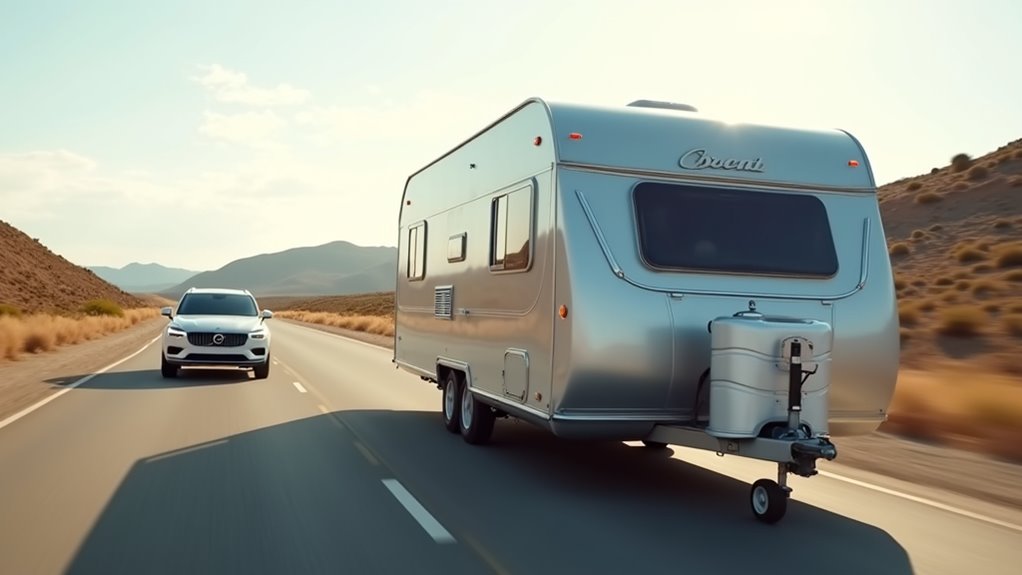
Getting your caravan to stop snaking requires understanding one crucial factor that most drivers completely overlook.
Nearly 40% of caravan accidents stem from snaking incidents that could’ve been prevented with proper preparation. You’re probably towing safely most of the time, but it’s those unexpected moments when physics takes control that’ll catch you off guard. The good news? There’s a science to keeping your caravan stable, and once you understand the key factors—from weight distribution to emergency responses—you’ll transform those white-knuckle moments into confident, controlled journeys that keep everyone safe.
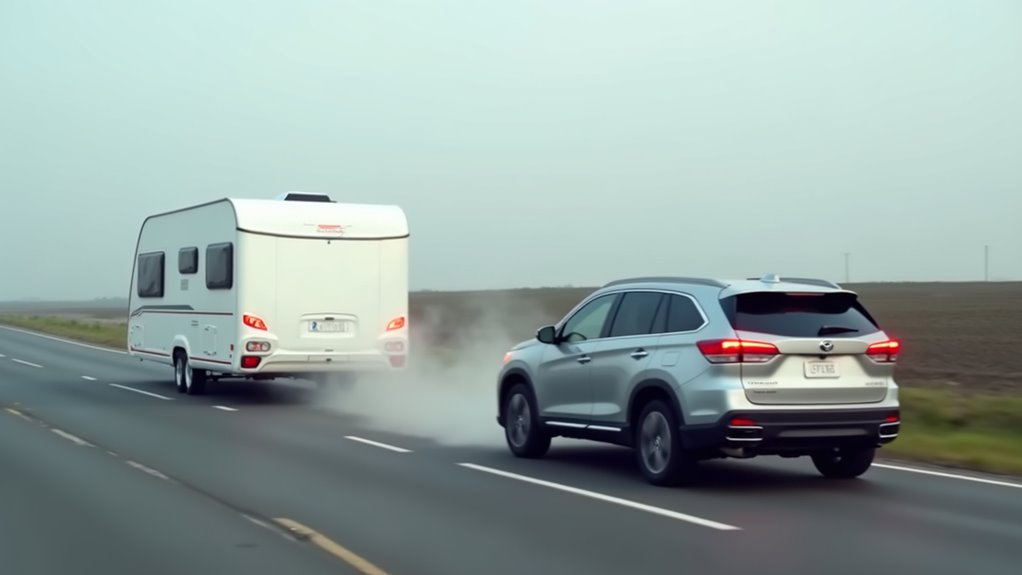
When you’re towing a caravan down the highway, you’re fundamentally creating a complex mechanical system where two vehicles work together through a single connection point. The caravan naturally wants to follow your car’s path, but physics creates instability.
When external forces like crosswinds, passing trucks, or slight steering corrections affect your caravan, it can start oscillating side to side.
This snaking motion occurs because the caravan’s center of gravity sits behind its axles, making it inherently unstable. Once oscillation begins, it amplifies quickly if you don’t respond correctly.
The caravan pushes your car’s rear end sideways, which then affects your steering. Understanding this relationship is vital—you’re not just driving a car anymore, but managing a dynamic system where both vehicles influence each other’s behavior.
Just as proper preparation matters for cold-weather adventures, ensuring your caravan is correctly loaded and balanced before departure is crucial for preventing dangerous snaking incidents on the road.
While understanding the physics helps explain why snaking happens, you’ll prevent most incidents by getting your weight distribution right from the start. Keep 60% of your caravan’s weight ahead of the axle and 40% behind it. Place heavy items like water tanks, batteries, and tools in front compartments near the towing hitch. Don’t store anything heavy at the rear – it acts like a pendulum that amplifies swaying motions.
Load items low and secure everything tightly. Loose objects shifting during travel can instantly destabilize your caravan. Check your nose weight using proper scales – it should be 5-7% of your caravan’s total weight. Too little creates instability; too much overloads your car’s rear suspension.
Distribute weight evenly from side to side to prevent rolling motions that trigger snaking. Proper preparation with camping essentials ensures your adventure starts safely before you even reach your destination.
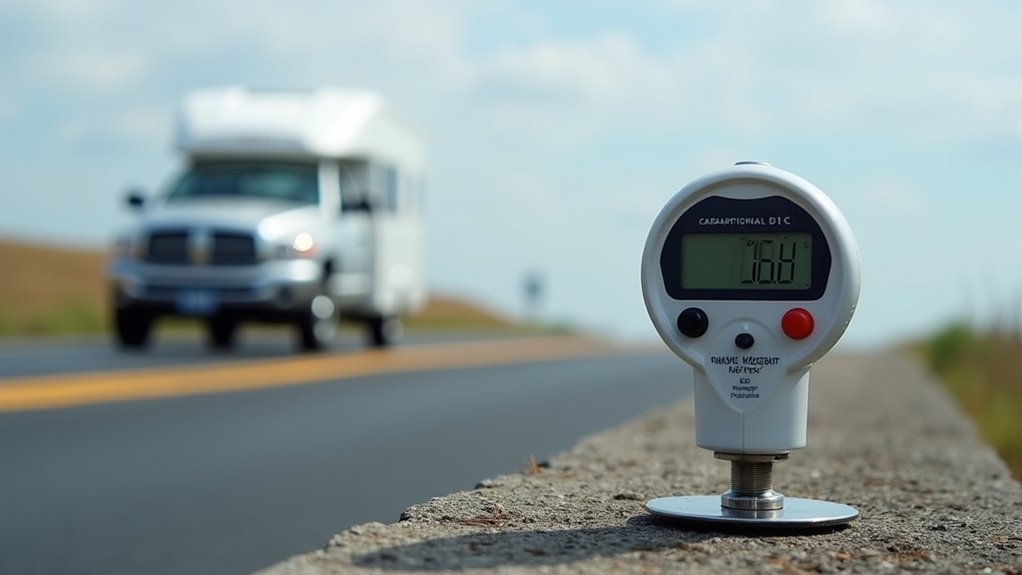
Getting your nose weight calculation right requires some simple math and the right measurements. You’ll need to determine the ideal range for your specific caravan and towing vehicle combination.
Here’s how to calculate your correct nose weight:
Most caravans work best with nose weights between 50-100kg. If you’re getting readings outside your calculated range, you’ll need to redistribute the load inside your caravan until you hit that sweet spot.
While proper weight distribution is crucial for road safety, adventurous travelers might also consider exploring America’s stunning glacier climbing opportunities during their camping journeys.
Since your tow vehicle’s capabilities directly impact your safety and the caravan’s stability, you’ll want to match your car’s specifications to your caravan’s requirements before you hit the road.
Check your vehicle’s maximum towing capacity – never exceed this limit. Your caravan’s loaded weight shouldn’t surpass 85% of your car’s kerb weight, especially if you’re new to towing. This ratio ensures better control and reduces snaking risks.
Consider your engine’s torque output too. Diesel engines typically provide better low-end pulling power than petrol variants.
Manual transmissions offer more control on hills, while automatics can overheat under strain.
Don’t forget about your car’s suspension and braking system. Heavy-duty suspension helps maintain stability, while properly functioning brakes are essential when stopping additional weight safely.
With current economic conditions affecting the RV market, dealers may offer better financing options or trade-in values that could help you upgrade to a more suitable tow vehicle.
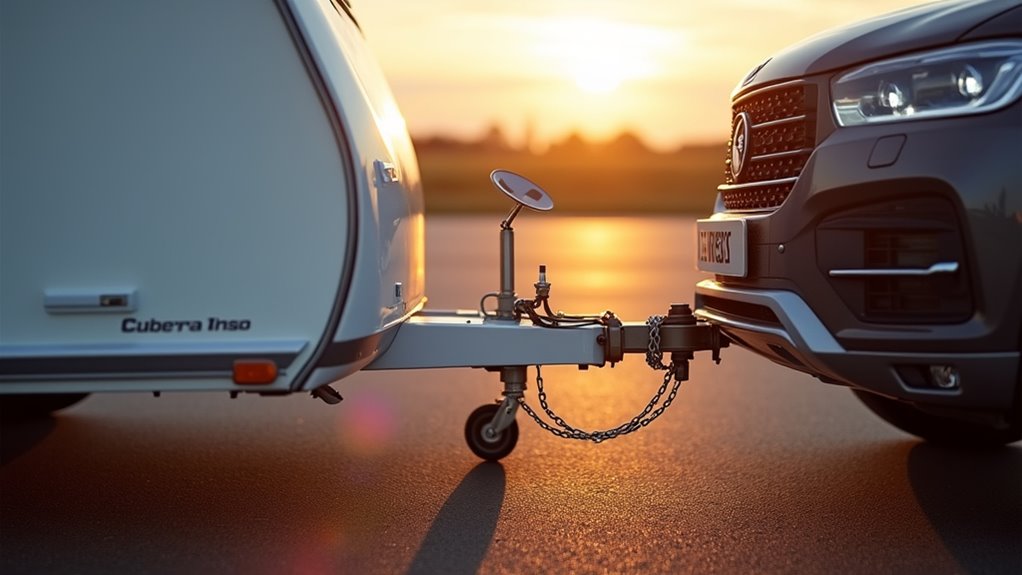
Before you attach your caravan and head out, you’ll need to complete a thorough inspection that can prevent dangerous snaking incidents. These checks might seem tedious, but they’re your first line of defense against losing control on the road.
Start with your caravan’s condition and connections:
Don’t forget to examine your tow vehicle’s rear suspension and ensure nothing’s dragging underneath. A methodical approach to these inspections takes just minutes but can save your life. Remember that proper loading distribution is crucial, as improper weight placement can trigger caravan snaking even when all other safety checks are completed correctly.
Once you’re on the road, maintaining proper speed becomes your most powerful tool for preventing caravan snaking. Keep your speed below 60 mph, even when legally permitted to go faster. Higher speeds dramatically increase snaking risk and reduce your reaction time.
Accelerate gradually when pulling away, avoiding sudden throttle inputs that can destabilize your outfit. When approaching hills, maintain steady momentum rather than accelerating mid-climb. This prevents weight transfer issues that trigger snaking.
Leave generous following distances – at least four seconds behind other vehicles. You’ll need extra braking distance, and sudden stops can cause dangerous oscillations.
Watch for crosswinds, particularly when passing large vehicles or exiting tunnels. Reduce speed preemptively in windy conditions, as gusts can instantly trigger snaking at higher speeds.
If you’re expecting moms planning to tow a caravan for camping trips, these speed management principles become even more critical for ensuring your safety and comfort on the road.
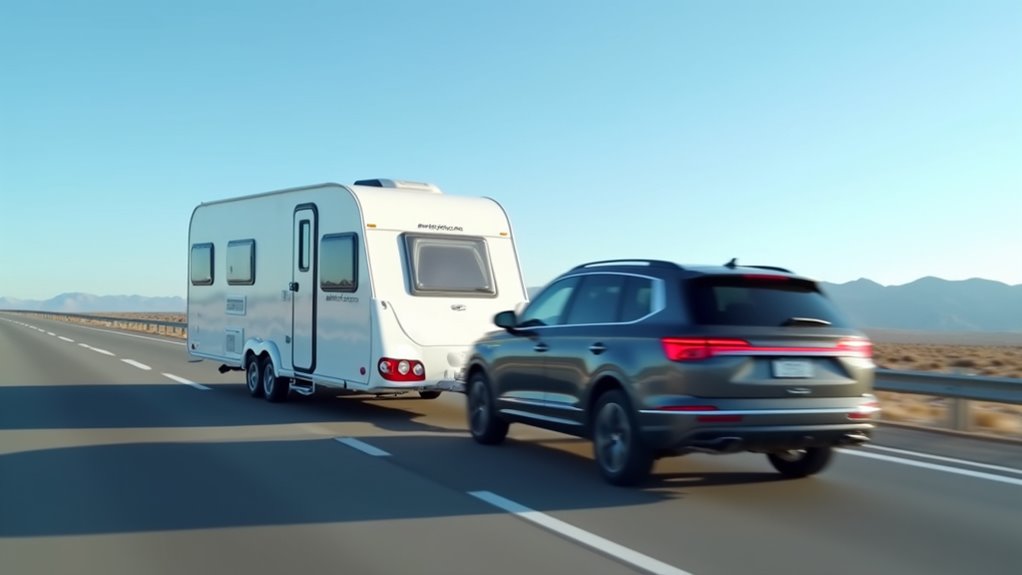
While maintaining proper speed helps prevent snaking, you’ll also need to recognize the subtle early warning signs that indicate your caravan is becoming unstable. Catching these signals early gives you time to react before full snaking begins.
Watch for these warning signs:
Don’t ignore these symptoms—they’re your caravan telling you something’s wrong. The moment you notice any instability, gently ease off the accelerator without braking hard. Keep your steering input minimal and let the outfit naturally slow down and regain stability.
Before you even hitch up your caravan, make sure you’ve chosen the right camping style that matches your experience level and comfort with towing larger rigs.
Even when you’ve spotted the early warning signs, sometimes snaking can still develop into a more serious situation that demands immediate action. Don’t panic—stay calm and focused.
Gradually ease off the accelerator without sudden movements. Avoid braking hard, as this’ll worsen the snaking motion. Keep your steering wheel steady and resist the urge to overcorrect by turning into the sway.
Let the caravan settle naturally while you slow down smoothly.
If the snaking continues, gently apply your caravan’s brakes using the manual brake controller if you have one. This can help straighten the unit.
Find a safe place to pull over as soon as possible. Once stopped, check your tire pressures, weight distribution, and hitch settings before continuing your journey.

Although emergency techniques can help you manage snaking when it occurs, investing in stabilizer systems and anti-snake technology offers a proactive approach to preventing the problem altogether. These systems work by dampening oscillations before they escalate into dangerous snaking motions.
Modern anti-snake devices include:
You’ll find these technologies particularly valuable when towing in challenging conditions like crosswinds or when overtaken by large vehicles.
While they’re an investment, they markedly reduce your risk and provide peace of mind on every journey.
You can explore the latest stabilizer technology and safety equipment at Britain’s Motorhome Show, where manufacturers showcase their newest anti-snake systems alongside other towing innovations.
Weather conditions play a crucial role in caravan stability, and understanding how different environmental factors affect your towing experience will help you make safer decisions on the road. Strong crosswinds are your biggest threat, especially when passing large vehicles or traveling through open areas like bridges and plains. You’ll feel your caravan pushing against the tow vehicle, so reduce speed and maintain a firm grip on the steering wheel.
Strong crosswinds pose the greatest threat to caravan stability, especially when passing large vehicles or crossing exposed areas like bridges.
Heavy rain creates slippery conditions that increase snaking risk. Allow extra following distance and avoid sudden movements.
Hot weather affects tire pressure, so check it regularly—underinflated tires contribute to instability.
Snow and ice demand extreme caution; consider postponing your trip if conditions are severe. Always monitor weather forecasts and adjust your travel plans accordingly.
If you’re considering towing a boat alongside your caravan adventure, weigh the benefits of renting versus buying to determine the most practical option for your specific trip requirements.
You’ve got all the tools in your toolbox now to keep your caravan dancing in perfect harmony behind you rather than throwing a dangerous tantrum. Remember, prevention’s always better than cure – check your weight distribution, maintain proper speeds, and stay alert to warning signs. Don’t let overconfidence creep in; even experienced towers can face snaking issues. Follow these guidelines consistently, and you’ll enjoy safe, stress-free adventures on the road ahead.